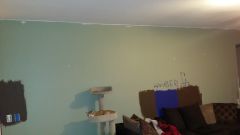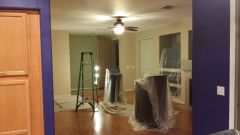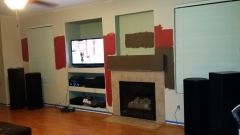-
Posts
1637 -
Joined
-
Last visited
Content Type
Forums
Events
Gallery
Everything posted by SuBXeRo
-
i upgrade many a time to what I have now. Size matters most of the time as do the settings from which your source is played from and through. Klipsch has a very good sound to them overall. The efficiency is a big perk and for the most part, they are a bassy speaker but controlled, nothing over the top and that performance sells me each and every time. They are also extremely well priced for what you get and you could pit them against speakers 10 times their cost. Some say the tweeter/horn combos are harsh and sometimes they are but their detail is is so incredibly clear. Klipsch has done revisions of its speakers which is generally denoted by the "II" iterations which are often smoothed out performance wise. Congrats! SVS is a good sub BTW, i heart mine. Sometimes i think there is a 10,000 lb gorilla in my house.
-
the space is coming along for sure. I am working at getting the stuff wire in wall with banana plug wall plates for clean installs all around. I am wiring for bi-wire/bi-amp for a 5.2 with XLR plates for the subs on each side of the room. The rear jacks could be done for a 7 channel if you don't do the "Bi" thing. Obviously if i do in-ceiling you dont really need the lower plates which are near the floor behind the couch but I am going to prewire for that anyways. I figure i might as well since i am going to be an attic monkey for a day. I could even install the RCW's i have to the left and right of the tv/fireplace and have front inwalls but that would be for a situation where the 7's went into hiding for whatever reason. Not bad for the holidays i suppose.
-
this is my room as of now. We are painting obviously haha
-
From the album: Living Room
-
From the album: Living Room
-
From the album: Living Room
-
From the album: Living Room
-
it takes talent to get a larger woofer to work well at higher frequencies.on thing i have learned from doing car audio is that driver placement is key. Well, with towers such as above, that isnt a problem. You get sound from one area with drivers close to each other which prevents separation. Most tweeters operating in the 2000 hz + region. Midranges are when you start to pickup lower extensions into the low hundreds to sometimes the mid 10,000's. Woofers, especially larger ones have trouble being accurate at higher frequencies because of their increased mass. The aforementioned are of a "typical" nature. My 6x9's in my car can go up to about 5,500 hz which is about the cone area of a 8" drivers but they were designed as such. each of these speakers have a different sonic signature because of different parts, different xovers and different cabinets so what you HEAR isn't necessarily attributed to the crossover point. There are just too many factors that come into play so say its just one thing. One thing you can also bring into the equation is frequency rolloff between drivers which is how quickly the driver stops playing frequencies as it transitions into the next driver or none at all in the case of a subwoofer. I brought up a point not too long ago about how i enjoy the heritages dedicated midrange. I find it to be more lively than the reference. Its probably due to some kind o driver separation or a bit more of an embellished midrange due to how the xo was designed. In any case, it sounds good to me! ideally, you want your drivers to all gain at the same pace so things always sound "even". i dunno, just food for thought here. If you A/B'ed the different frequencies you would most likely detect the differences but when you are transitions between 2 different drivers almost point-source, i'd think distinguishing the 2 would be difficult.
-
Pictures to accompany. I have my couch butted up to my rear wall with no good side walls. The fiance said niet to the rear in-walls i picked up so i am looking for an in-ceiling option. Anyone have this where the speakers are directly above you? Looking to do a 5.2 or 7.2 in the rear so just the addition of 2 or 4 drivers. Acoustic Sound Design has a BOGO sale going on the CDT-5800's. $400 for 2 is....OK, $800 for 4 just got spendy but they will timbre match as best as possible. Any thoughts on how it will sound coming from the ceiling and not necessarily behind you?
-
I am using it on my computer with two WB-14's attached. Sounds good to my ear, good form factor and works well. The only thing i wish they would incorporate is a sub out and an active crossover. To me, its meant for a computer or other small setup where you are probably going to have speakers with limited low end capability. The additions i suggested make sense and should be easy to incorporate. The noise floor is really quiet and i think it is just a good amp overall. I havent tested it on any of my other speakers though yet.
-
fly me in then count me in
-
im guessing rf-3's or sf-3's towers
-

Complete Rf-7ii System Purchase (Best Deal Of My Life)
SuBXeRo replied to Youthman's topic in Home Theater
what the efffffff. I bow to you. Thats insane. My fiance would hang me out to dry and then some. But id do it anyways haha. Wow. Congrats, what an awesome purchase! -
if it makes you feel any better, it's a receiver. Unless you spend bucu bucks on one and even at that it isn't worth it, most receivers have a very similar performance curve when it comes to amplification. Almost every single class A/B amp is a slacker and has way overstated outputs. Sound and Vision mag or Home Theater mag very often bench test receivers and amps and I'd say that at full bore, all channels driven, most receivers will put out about 50% of what the manufacturer says. I am seeing it more and more that they are more clearly labeling things (tested with only 2 channels) which yields more power but isn't reflective of its use as a home theater multi-channel receiver. Its a deceitful and overlooked marketing tactic that they use. The good thing is that the Pioneer SC line with Class D amps tend to adhere closer to the rated specs than its competitors. What you also have to realize is that have you have a dedicated subwoofer and cross your speakers at 60hz or 80hz, yours speakers shouldn't be power gobblers as if you had left them on full range and letting them reproduce those low bass tones which take power. In actuality, klipsch speakers are really efficient and the power that receivers put out are generally sufficient barring the low end receivers but even they generally work well. You can get low end out of your speakers on full range but most say, including myself that it isn't as clean and crisp as it could and should be. Most don't realize or don't care. Ignorance is bliss when it comes to audio until you've become enlightened. The benefits of a separate power amp are clear after owning one. The sound is generally more refined and smooth with a ton of performance that is realized in the lower end of the frequency spectrum. This isn't a separates vs receiver debate but something i wanted to add. After having gone to separates though, I don't have any desire to go back to just a receiver for my home theater needs. This isn't to scare you out of a receiver though. Receivers fit the needs of the many and for a small but growing group, separates are the way of life.
-
Class D can be good and bad just like class A/B can be good and bad. I'd buy the receiver and test it. Do you have a return period? Test it out and see if it meets your needs. Its just a different topology at the end of the end. A lot of audiophiles don't like it because its digitally based and not analog. They say that some of the sound is "lost" or it lacks warmth. Every amplifier has its own unique sonic signature. The sooner you learn this fact, the better off you will be. To further make it more...interesting, keep in mind that each and everyone hears the sound from a unique perspective, their own. The best most uninhibited sound you can can get is from a purely analog source. That would mean a class A tube amplifier with a turntable for instance. There would be ZERO digital incursion here because nothing has been converted to 1's and 0's for instance. Class A is extremely inefficient and expensive and produces a ton of waste heat. A lot of people say they can heat part of their house or at minimum the room the amplifier is in. For the most part, Class A does not fit the mainstream household budget nor its ease of use and robustness in a multi-channel environment. Class A is typically used for 2 channel stereo setups. Rotel is owned by bowers and wilkins and is one of the first mainstream HiFi companies to start employing Class D amplifiers in their multichannel amps. They make a good product and stand behind their Class D amps. I havent heard them but I can only assume that they sound pleasing. It's on my to-do list to hear them at some point although I dont think i want to make a change any time soon from what I have.
-
A lot of equipment could be THX certified and if it was, it would be more expensive because of the licensing to be THX certified. Its just another marketing tool. Class D amplification is the topology of the amps design. Class D is extremely efficient and only uses the power it needs. Traditional receivers and most amplifiers are class A/B because they offer a good balance of sound quality refinement and efficiency but has a good amount of waste heat. Class D runs cooler and is more efficient but is harder to get good sound quality out of. Keep in mind, the Class D revolution has really only come to a head in the last few years and there has been a ton of improvement in the technology. Personally, I have found some class A/B and Class D to have noisy ground floors (when you have no sound being played, the noise you hear in the background). You really aren't supposed to hear anything with the amp on but sometimes it happens depending on the amps design. There are also other classes of amps such as G and H which are similar to A/B and offer better sound quality with far better efficiency than A/B nearing class D efficiency. Class G and H work on different voltage rails in the transformer and change when additional power is needed which is not how class A/B functions, it just stays on a single rail. When the rails change, its inaudible and indistinguishably quick. I have this in my ARC audio car amps. Outlaw audio also makes a monoblock employing that technology. My 7 channel outlaw amp is class A/B and has a quiet noise floor. The Pioneer SC amps have gotten good praise over the years it seems. I've read a few reviews and they have all been positive. Personally, I think the technology of Class D belongs in a receiver since you have limited space and heat is a concern. You get really good output that a class A/B would have a damned hard time mimicking. Face value, that receiver looks good. Pioneer usually has one of the best gizmo/trinket and quality to price ratio of the main brands. For some, this wins them over. I haven't done any research on it otherwise but i'd say if it it fits, you sits.
-
bow chicka bow wow
-
ermagherd, finally!!!!
-
i use an APC H15 http://www.apc.com/products/resource/include/techspec_index.cfm?base_sku=H15BLK, i got it for $50 on craigslist. Works well. I have a G15 too but that started make noise, a hum pretty much but thats a rackmount conditioner, not really geared for HT. Its currently being used in my dads house since the cabinet and room it is in makes the noise inaudible really.
-

Youthman's 2ch Setup Just Received a Sweet Upgrade!
SuBXeRo replied to Youthman's topic in 2-Channel Home Audio
my 7's sing on the 125 watts they eat up but its coming from the outlaw power amp. Its actually quite surprising how loud they get on that power and i havent had them peter out, my ears did instead. -

Youthman's 2ch Setup Just Received a Sweet Upgrade!
SuBXeRo replied to Youthman's topic in 2-Channel Home Audio
congrats on the setup! the b&w's bass will peter out far before the rf-7's will at higher volumes. For shits and giggles, hook up a power amp to the 7's and crank it to the put of uncomfortable and you will hear that bass you were expecting you'd hear from 2 10's. At lower volumes, the bass is really sedate IMO. I typically bump up the eq of the low end for the 7's to help because my normal listening volume is not 100+ db. you are spot on with the "enveloping" and "ginormous" stage they produce. That's why I think they are so great for home theater and why i wont unload them. I find it interesting though that the b&w's have more bass than the RF-5's. I suspect placement was to blame and front firing vs rear firing ports. The RF-5's are bass hounds. I tested them a few years ago down to like 21 hz audible at very low volume. For me, those are my go-to's for music listening, hands down. Well, no but kinda, the quartets i have sound great to my ear for more vocalist music like lana del ray. I was in bestbuy the other night and auditioned the B&W CM-9's and they have a great sound. I have always liked b&w but not their prices. I think that they have some great performance but for $3,000 a pair, i'll take my used $200 RF-5's. The sound is different but the midrange in the CM-9 is great. I didn't audition the ones you have though which i should have but the nice gloss black and pretty looking speakers caught my eye. Actually, not yours exactly but the newer 600 series. I enjoy different speakers at different times but at the end of the day, what we hear is subjective. I think the budget is the determining factor at the end of the day. If i could afford the CM9's, they'd be sitting in my house right now pissing off the fiance because i have more speakers. My dad has had a pair of b&w's for over 25 years and they are still going strong. -

Rf-42ii (2) tower, 1 center, (2) surround... good deal?
SuBXeRo replied to WaGGuM's topic in Home Theater
thats a great setup for a smaller room!






